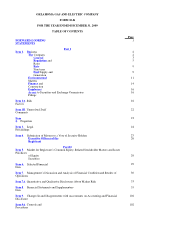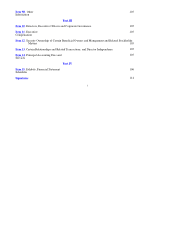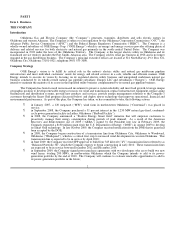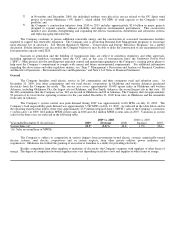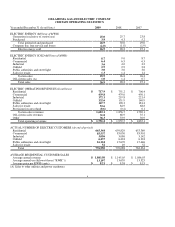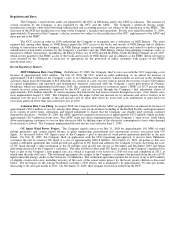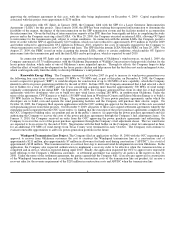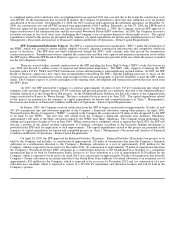OG&E 2009 Annual Report Download - page 12
Download and view the complete annual report
Please find page 12 of the 2009 OG&E annual report below. You can navigate through the pages in the report by either clicking on the pages listed below, or by using the keyword search tool below to find specific information within the annual report.
of the Cimarron-Lawton East Side 345 kV line at an estimated cost of approximately $8 million for the Company, which is expected
to be in service by December 2012. On June 19, 2009, the Company received a notice to construct the Balanced Portfolio 3E projects
from the SPP. On July 23, 2009, the Company responded to the SPP that the Company will construct the Balanced Portfolio 3E
projects discussed above beginning in early 2010. The capital expenditures related to the Balanced Portfolio 3E projects are presented
in the summary of capital expenditures for known and committed projects in “Item 7. Management’s Discussion and Analysis of
Financial Condition and Results of Operations – Future Capital Requirements.”
Conservation and Energy Efficiency Programs. In June and September 2009, the Company filed applications with the
APSC and the OCC seeking approval of a comprehensive Demand Program portfolio designed to build on the success of its earlier
programs and further promote energy efficiency and conservation for each class of Company customers. Several programs are
proposed in these applications, ranging from residential weatherization to commercial lighting. In seeking approval of these new
programs, the Company also seeks recovery of the program and related costs through a rider that would be added to customers’
electric bills. In Arkansas, the Company’s program is expected to cost approximately $2 million over an 18-month period and is
expected to increase the average residential electric bill by less than $1.00 per month. In Oklahoma, the Company’s program is
expected to cost approximately $45 million over three years and is expected to increase the average residential electric bill by less than
$1.00 per month in 2010 and by approximately $1.40 per month in 2011 and 2012 depending on the success of the programs. In
addition to program cost recovery, the OCC also granted the Company recovery of: (i) lost revenues resulting from the reduced KWH
sales between rate cases and (ii) performance-based incentives of 15 percent of the net savings associated with the programs. A
hearing in the APSC matter was held on October 29, 2009 and the Company received an order in this matter on February 3, 2010. A
settlement agreement was signed in the OCC matter by several parties to this case on January 15, 2010 with a hearing being held on
January 21, 2010, where the parties who had not previously signed the settlement agreement indicated that they did not oppose the
settlement agreement. The Company received an order in the OCC matter on February 10, 2010.
Smart Grid Application. In February 2009, the President signed into law the ARRA. Several provisions of this law relate to
issues of direct interest to the Company including, in particular, financial incentives to develop smart grid technology, transmission
infrastructure and renewable energy. After review of the ARRA, the Company filed a grant request on August 4, 2009 for $130
million with the DOE to be used for the Smart Grid application in the Company’s service territory. On October 27, 2009, the
Company received notification from the DOE that its grant had been accepted by the DOE for the full requested amount of $130
million. Receipt of the grant monies is contingent upon successful negotiations with the DOE on final details of the award. The
Company expects to file an application with the OCC requesting pre-approval for system-wide deployment of smart grid technology
and a recovery rider, including a credit for the Smart Grid grant during the first quarter of 2010. Separately, on November 30, 2009,
the Company requested a grant with a 50 percent match of up to $5 million for a variety of types of smart grid training for the
Company’s workforce. Recipients of the grant are expected to be announced in the first quarter of 2010.
See Note 13 of Notes to Financial Statements for further discussion of these matters, as well as a discussion of additional
regulatory matters, including, among other things, system hardening filing, security enhancements filing, FERC formula rate filing
and review of the Company’s fuel adjustment clause.
Regulatory Assets and Liabilities
The Company, as a regulated utility, is subject to accounting principles for certain types of rate-regulated activities, which
provide that certain actual or anticipated costs that would otherwise be charged to expense can be deferred as regulatory assets, based
on the expected recovery from customers in future rates. Likewise, certain actual or anticipated credits that would otherwise reduce
expense can be deferred as regulatory liabilities, based on the expected flowback to customers in future rates. Management’s expected
recovery of deferred costs and flowback of deferred credits generally results from specific decisions by regulators granting such
ratemaking treatment.
The Company records certain actual or anticipated costs and obligations as regulatory assets or liabilities if it is probable,
based on regulatory orders or other available evidence, that the cost or obligation will be included in amounts allowable for recovery
or refund in future rates.
At December 31, 2009 and 2008, the Company had regulatory assets of approximately $451.4 million and $464.3 million,
respectively, and regulatory liabilities of approximately $363.0 million and $164.4 million, respectively. See Note 1 of Notes to
Financial Statements for a further discussion.
8



